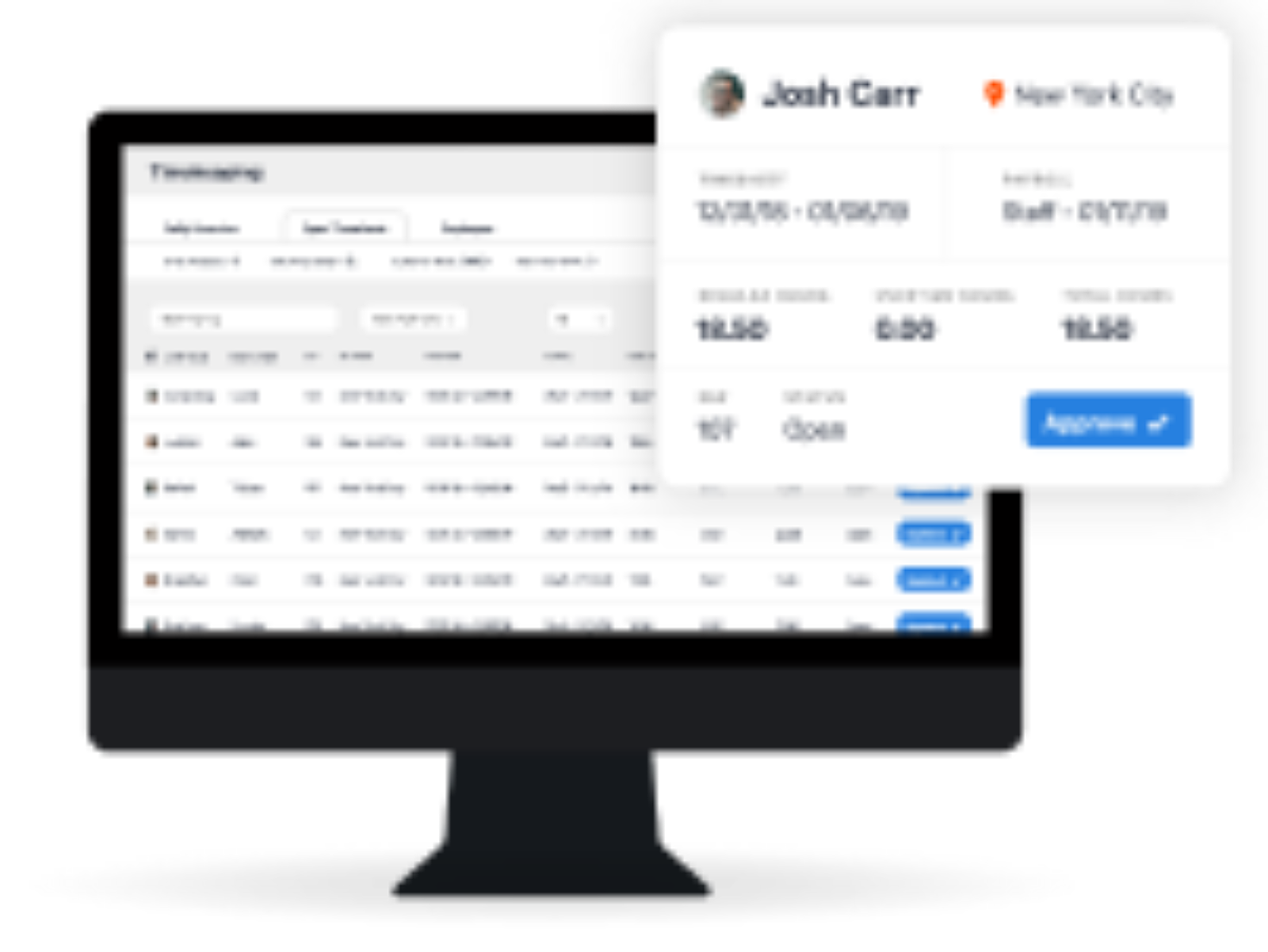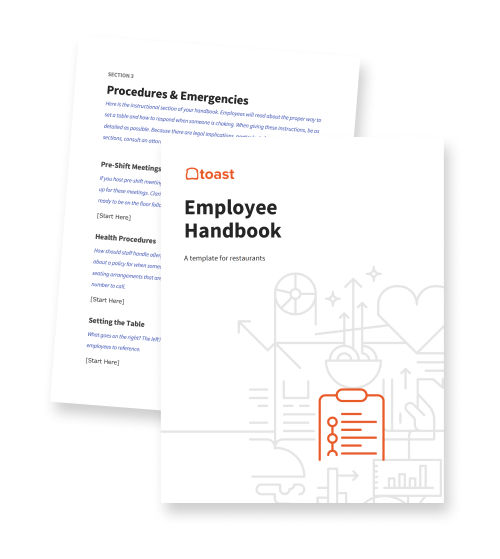
How to Run a Pre-Shift Meeting With Restaurant Staff
Learn how to lead a pre-shift meeting that sets up your restaurant staff for a productive and profitable shift.

Chelsea VerstegenAuthor


Employee Handbook Template
Outline your restaurant’s staff policies in this customizable Word doc to help restaurant management and staff get on the same page.
Get free downloadIf there’s one universal trait of a successful restaurant, it’s the ability to run great shifts day after day, week after week. Daily pre-shift meetings are a core part of that steady success.
When the steps of service flow smoothly, when the food arrives in a timely manner, when tables are set and cleared in record time, and when your patrons leave stuffed and satisfied, it feels freakin’ good. This perfect harmony is what we all strive for.
Nurturing a focused, informed, and energized team ensures everyone stays on the same page and everything functions smoothly. In this article, you’ll learn how to conduct an effective pre-shift huddle, build a pre-shift meeting structure, and organize your day to guarantee excellent customer satisfaction.
Table of Contents
What is a Pre-Shift Meeting?
Why Your Restaurant Needs Pre-Shift Meetings
How to Run a Successful Pre-Shift Meeting
Final Thoughts & Considerations
Restaurant New Hire Onboarding Checklist
Bringing new employees onto your team can be both exciting and challenging. Use this free PDF checklist to set your staff up for success.

What is a Pre-Shift Meeting?
A pre-shift meeting occurs before meal service in a restaurant, where the manager on duty huddles up their team to relay important updates, offer advice, and get the team excited for the upcoming events of the day. Sometimes, these meetings happen over a shared staff meal; other times, they're just a quick five-minute update.
The pre-shift meeting happens before the lunch or evening rush takes over. It’s a period where managers can share updates to the menu, answer accompanying questions, assign side work and pre-shift work, and address other housekeeping tasks.
For example, managers could praise front-of-house staff for their efforts during the previous shift. Alternatively, they could say things like, “Today, we’ve got X amount of bookings”, or “Today, the specials are steak tartare”, or discuss similar details.
Why Your Restaurant Needs Pre-Shift Meetings
The pre-shift meeting can be an effective tool to motivate restaurant staff. As a manager, you can focus the collective energies of your team toward a singular mission: delighting guests and creating memorable dining experiences that exceed expectations.
It’s also a great way to ensure everyone is on the same page. By outlining the meeting agenda, discussing the previous shift, and explaining the day’s expectations, you can streamline your restaurant’s operations and guarantee a successful shift.
You may also want to keep your employees in the loop about company updates. Once a month at Mei Mei Street Kitchen in Boston, MA, pre-shift meetings include 10 minutes of financial updates, 10 minutes of announcements, and 30 minutes of peer training. This constant training helps Mei Mei cultivate a positive and productive restaurant culture. You can find more about the restaurant’s smooth operations in this Toast interview with Mei Mei founder Irene Li.
Inform, Instruct, Inspire: How to Run a Successful Pre-Shift Meeting
In this section, we’ll take you through how best to plan and execute a pre-shift meeting to maximize your motivational powers and set up your staff for a successful shift.
To get the most out of your pre-shift meetings, it’s important to implement some structure. This is where the “Three I’s” come in: inform, instruct, and inspire. Here’s an example of how you could structure your pre-shift meeting:
0:00-1:00 min: Welcome and general overview.
2:00–5:00 min [Inform]: Give business updates and side work assignments.
6:00–11:00 min [Instruct]: Offer advice and teachings to build skills.
12:00–15:00 min [Inspire]: Praise individuals and give pep talks.
Following this general outline will help you use your limited pre-shift meeting time effectively. To really maximize your time, make sure you plan your meetings ahead of time to avoid forgetting important details or leaving out certain information.
Now, we’ll teach you how to conduct an effective pre-shift meeting for your restaurant.
Plan Your Meetings
You should always prepare the theme of your pre-shift meeting and its content ahead of time. While there are many steps and processes that make up a great shift, one factor is certain: nothing beats preparation.
A pre-shift meeting template is a great way to promote open communication between your team members, document what was covered during the discussion, and track the progress on any tasks that were assigned.
Post your pre-shift notes on a clipboard where every team member can see them. If you have multiple restaurant managers, ensure they take turns facilitating the day’s pre-shift meetings. Require managers to fill out the pre-shift notes in advance and share them with the rest of the management team so everyone’s on the same page.
You could also rotate the responsibility of running the pre-shift meetings amongst staff members or have different staff members cover different sections. This will help staff get more involved in your restaurant’s operations and feel comfortable presenting in front of large groups, a skill you should have looked out for when hiring front-of-house servers.
When it's time for the meeting, grab a blank version of the pre-shift notes template and go.

Inform of the Shift Ahead
After a brief welcome and introduction, the first section of your pre-shift meeting should cover general information about the day ahead. This could include details like:
Team roles
Scheduling changes
Updates to employee payroll
Chef specials
Special events or reservations
Projected level of busyness
Weather implications on service
Team birthdays
It’s important to keep your staff informed about company updates, particularly when things can change so quickly from day to day. If you’ve created a new restaurant staffing schedule, for instance, employees need to know about this as soon as possible.
Instruct Your Employees
The second section of the pre-shift meeting is your opportunity to teach your team new skills, offer guidance, and give your humble advice.
For example, your chef could discuss menu adjustments, specials, or a limited availability featured dish. Alternatively, your bar manager could discuss a special featured cocktail or invite a rep from your alcohol distributor to come in and speak about proper pairing techniques.
Teaching your staff new soft skills will help them serve guests more attentively and boost the overall atmosphere for the customers. Pair this with the Toast Guest Feedback software, and you can apply feedback to create the ultimate guest experience.
Sharing advice will also help your employees develop professionally and advance their careers. Equipping your front-of-house staff with the right hospitality skills will ensure they give your business a stellar reputation as the face of your brand to guests and prospective customers.
Inspire Your Staff to Success
A rousing send-off to your staff is the perfect way to motivate them for the shift ahead. Focus on getting your employees excited for the day (or night) ahead. Share an inspirational quote (avoid the cheesy ones), give a pep talk, or start a small contest. Employee gamification tactics are popular ways for restaurant managers to use the power of healthy competition to drive sales and staff engagement.
Typically, these contests revolve around who can sell the most of a certain type of beer, cocktail, or appetizer in a given period of time. You can reward either individuals or the whole team for their efforts. For example, the three top sellers might get to hand off their side work for a week, but if the entire staff surpasses a certain number of units sold, they get a pizza party. Whatever the prize, make sure it’s a great incentive.
This final section of your pre-shift meeting is also a chance for you to acknowledge or recognize team members who did an outstanding job in the past week. An accomplishment, no matter how small, is still worthy of praise.
Thank your staff trainers for onboarding assistance, your line cooks who busted out a big rush like champions, or an individual for surpassing sales goals. Make it mandatory for your managers to find at least three team members or groups to thank for their efforts.
Employee Feedback Template
Use this customizable Word doc to guide self, peer, and manager reviews with your employees.

Be Consistent
Pre-shift meetings should become second nature for both management and staff. Make it a requirement for your shift staff to attend all pre-shift meetings and ensure you host them at the same time — usually 15 minutes before the shift starts — and in the same place every day. If you can get into the habit, your staff will always remember to be there. Make it easy for them.
Make sure your pre-shift meetings are as engaging as they are valuable. They shouldn’t be 15-minute rambles where you lose control of the room but structured discussions. Consistently delivering helpful information that your staff will retain and take into the shift is what will make your meetings effective.
Final Thoughts & Considerations
Planning and executing a pre-shift meeting in the right way is crucial to the success of your restaurant. Fortunately, by following the guidance outlined in this article, you can give yourself the best chance of instigating a positive and productive shift.
Start with a pre-shift meeting template, followed by three short phases of information, instruction, and inspiration. Remain friendly and engaging, and always sign off with optimistic sentiments. Do this for 15 minutes before each shift, and you’ll be surprised how quickly it can yield positive results.
To maximize the success of your pre-shift meeting and your restaurant’s operations in general, you should use the right tools. Toast provides a wide range of employee management software and smart tech solutions for the hospitality industry. Get your demo today.
FAQs
What is the Purpose of a Pre-Shift Meeting?
The purpose of a pre-shift meeting is to inform your employees of the shift ahead, offer praise and recognition to deserving staff members, and get your font and back-of-house workers in the zone for the day (or night) ahead.
How Long Should a Pre-Shift Meeting Be?
Pre-shift meetings shouldn’t take up too much time, but you also need to cover a lot of points. You need to keep your employees engaged without withholding any important information. You should aim to keep your pre-shift meetings between 5 and 15 minutes long.
What Benefits Can Pre-Shift Team Meetings Provide?
Taking even just five minutes before each shift can create a range of benefits. Pre-shift meetings can boost staff productivity, increase employee engagement, and foster a healthy workplace environment. Plus, you can offer advice and quick training to upskill your workers.

Is this article helpful?
DISCLAIMER: This information is provided for general informational purposes only, and publication does not constitute an endorsement. Toast does not warrant the accuracy or completeness of any information, text, graphics, links, or other items contained within this content. Toast does not guarantee you will achieve any specific results if you follow any advice herein. It may be advisable for you to consult with a professional such as a lawyer, accountant, or business advisor for advice specific to your situation.
Subscribe to On the Line
Sign up to get industry intel, advice, tools, and honest takes from real people tackling their restaurants’ greatest challenges.
